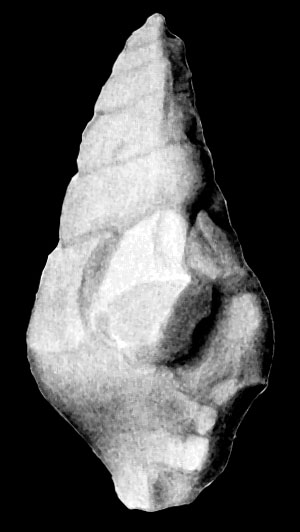Species / Tibia Pseudomokattamensis
Stromboidea
Original Description of Tibia pseudomokattamensis by Eames, 1952a , p. 65:
- "Shell large, rather stoutly fusiform in shape, the anterior part of the columella missing. Five spire whorls are preserved, and there were probably a few more at the apex between the first whorl preserved and the protoconch. No trace of any ornament. Whorls practically flat-sided, very slightly convex, a little steppd at suture, approximately half as high as they are wide. Sutures linear. Body whorl, which occupies about half the height of the shell in the holotype, moderately large for the genus, rather flattened on its upper part, medially vaguely subcarinate, the base gently convex and then gently concave near the commencement of the columellar region. Aperture rather nattowly oval, the anterior canal being broken. Growth lines not observed."
- "Dimensions. Holotype: height 92.3 mm. (incomplete); width 43.0 mm."
Stratum typicum: Sirki Shale / Kohat Limestone (local subzone 4d), (Eocene?, Miocene?)
Locus typicus: Kohat area (Sirki Paila), Pakistan
Tibia pseudomokattamensis Eames, 1952, pl. 3, fig. 72
Comment Wieneke: might be an Amplogladius
1974
Meissner et al., 1974, p. D15:
- "The Sirki Shale was the name given by Eames (1952, p. 168) to a small 15-foot-thick exposure of Eocene shale overlying the Kohat Formation near Sirki Paila (lat 33°27' N., long 71°3' E.). The shale is brown and contains beds of impure limestone. This shale development is seen only in the vicinity of Sirki Paila and is impractical to map regionally. The upper contact of the Kohat Formation is unconformable with the overlying Miocene Murree Formation. There is generally a thin conglomerate bed at this contact which is composed of pebbles of limestone of the Kohat Formation in a matrix of sandstone of the Murree Formation. In places a bed of ball-like concretions is just above the top of the Kohat Formation."
References
- Eames 1952. A contribution to the study of the Eocene in Western Pakistan and Western India. C. The description of the Scaphopoda and Gasteropoda from standard sections in the Rakhi Nala and Zinda Pir areas of the Western Punjab and in the Kohat district. Philosophical Transactions of the Royal Society, 236 B 1952: 1-168.
- Meissner, C.R., Master, J.M., Rashid, M.A. & Hussain, M. 1974. Stratigraphy of the Kohat Quadrangle, Pakistan;Geological Survey Porfessional Paper 716-D, US Government Printing Office, Washington, I-IV, 1-30, pls. 1-2, 1 map.
- Yu, 1975

